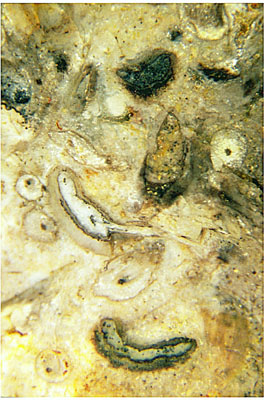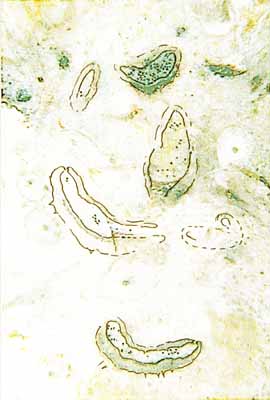Cluster of Trichopherophyton
sporangia
Not much is known about the sporangia of Trichopherophyton,
the
second-rarest higher plant in the Rhynie chert (Lower Devonian),
distinguished by
bristles on its upper parts.
Apparently the plant is prone to rapid decay. Hence, detached bristles
and sporangia are often the only remains left in the chert.
The original publication shows one comparatively well preserved axis
fragment with two attached sporangia, however, "the spatial
distribution of these reproductive organs in relation to each other and
to the whole shoot system
must remain a matter of uncertainty until more extensive and better
preserved remains are discovered" [1].


A small chert sample of 0.12kg found in 2002 is interesting in this
connection as a cluster of 6 sporangia is seen on its raw surface.
Subsequently prepared 4 cut and polished faces reveal poorly preserved
axis sections with bristles but no more sporangia. Therefore, the
clustering is certainly not incidental although
an axis related to the 6 sporangia is not seen. It may be hidden
behind, more or less decayed.
The aspect of the cluster suggests that the sporangia are arranged not
in single file but with a more variable orientation and irregular
spacing.
Photograph and drawing: Trichopherophyton
sporangia on
the raw surface of a small chert fragment, (contours outlined on the
right): first evidence of their arrangement in irregular clusters.
Height of the picture 11mm.
H.-J.
Weiss 2008
[1]
A.G.
Lyon, D. Edwards: The first Zosterophyll from the Lower
Devonian Rhynie
Chert.
Trans. Roy. Soc. Edinburgh: Earth
Sci. 82(1991), 323.
 |
 |
22 |





